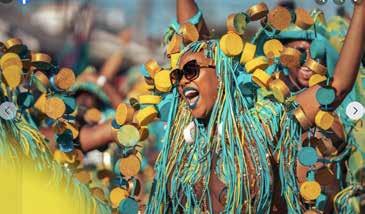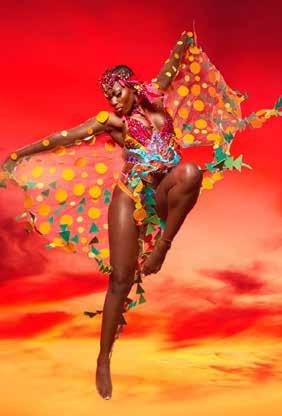
2 minute read
Ritual, Pageantry, Fashion
By C.L. Blackburn Staff Editor
The question is which came first the pageantry of ritual or the gaiety of performance? We note the religious and or costume regalia to denote, baptism, weddings, death, and the crowning of royalty. And then there was the festivity celebrating the festivity. The costumes of both were in some way complimentary whether it was the colors or the shapes of the clothing designs that evolve from the foundation of each culture, whether it was Chinese, Japanese, Irish, English, Nigerian, Egyptian, or Sudanese. The nature of the geographical landscape providing the colors, the fibers for fabric, textures and lines all helped to contextualize the designs that emerged to marry the two.
Advertisement
Today we see our entertainers dressed on stage come to life off stage. The world has become a stage of performers, and everyone dresses for that stage. The uniforms of IBM, The Chicago Tribune, AT&T, and most corporate entities have all but Vanished, starting with the ‘Casual Friday’ movement in the workplace and now women go to work barelegged and unprotected by undergarments. LV had initiated the men’s suit which replaces long pants with shorts. It’s definitely the freedom of the Dawning of the Age of Aquarius when women burned bras. Today the casual unrestrained attire at the workplace is unsettling to those born before the 70’s.
The exposure of body parts other than faces, necks, arms, hands, and legs, exposing tattoos is daunting.
Inspiration
So, enter the Masqueraders wearing carnival costumes with wings and crowns leading a star studded performing cast to the backdrop of sweeping angel wings that drape and drag to the ground with gigantic clusters of butterflies, and capes of feathers, sequence you must make the connection of what fashion is all about.



Valmiki Maharaj, the creative director, and bandleader of the Lost Tribe is also a designer, editor, strategist, and visionary. Explains what we know, by adding their own spin on the theme and constructing their own costumes become fashion. It’s sort of like the Met Gala.
The streets of Victoria Square become the runway for the Trinidad and Tobago’s carnival known as largest in the Caribbean. . “We’re a strange mix of costuming, performance, entertainment, party, all in the same thing,” says the 37 year old Maharaj, who hails from Barataria, a borough east of Port of Spain. The celebration began as a humble tradition blossomed into a magnetic ritual that draws the diaspora home, and costuming is at the root of the spectacle.
The Lost Tribe is a young carnival troupe that put on its first road march seven years ago. Since their beginning, the costumes departed from the feather and headdress bikini mas (costume) most wretched trim has seen or worn. The Lost Tribe costumes are distinctly theatrical yet flattering and require more fabric than the standard bikini costume, thus striking a balance between cool and camp is a must. It is an intentional departure, insist Maharaj as explained to Vogue . It’s not surprising that
‘The Washing,’ designed by Peter Elias and Jeneile McCarthy, looks like something Wakanda royalty might wear to a mass. Not to be left out, there’s something for everyone. You will see yourself in the carnival in some colorful exaggerated form.
The theme for the next carnival season Maharaj suggests will signify freedom; shades of blue would symbolize its essence. According to him, blue soap is part of Caribbean heritage and is used to wash away, “bad mind,” akin to the Turkish Nazar (The Evil Eye or “Nazar” is an eye-shaped talisman which is believed to protect you against evil. The evil eye dates back thousands of years as one of the strongest symbolic images in the world.). Maharaj lets us in on a secret when he tells us that the carnival is a blessing performance where people come and experience something that, in some which way, changes their existence for the rest of the year, increases their energy, or recharges you.







